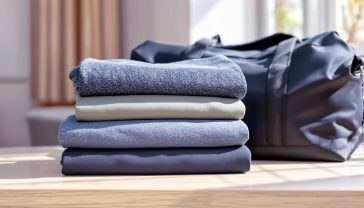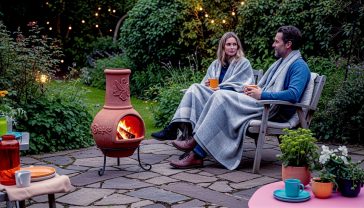Finding the Perfect Dog Bed: The Guide to Comfort, Health, and Happiness for Your Furry Friend
From orthopaedic beds for seniors to chew-proof options for puppies, this is the ultimate UK guide to choosing the right dog bed for your furry friend.

This post may contain affiliate links. If you make a purchase through these links, we may earn a commission at no additional cost to you.
It’s a classic scene in many a British household. The lights are low, the telly’s on, and you’re just settling into the comfiest spot on the sofa… only to find it’s already occupied. A pair of soulful eyes stare back at you from atop your favourite cushion, a gentle tail-thump suggesting you’re the one who’s in the wrong place.
While sharing our furniture with our four-legged family members is one of life’s great joys, giving them a dedicated space of their own is one of the kindest things we can do. A dog bed isn’t just a miniature mattress; it’s a sanctuary, a safe space, and a crucial tool for their physical and mental well-being. It’s their personal spot to retreat to after a muddy walk through the woods, a place to dream of chasing squirrels, and a supportive haven for their joints as they age.
But let’s be honest, the world of dog beds can be baffling. With endless options—from orthopaedic memory foam to chew-proof fortresses—how do you choose the right one? What does your dog really need?
Don’t worry. This is your ultimate guide. We’ll walk through everything you need to know to find the perfect bed for your furry friend, from decoding their sleeping style to understanding the nitty-gritty of materials and maintenance. By the end, you’ll be an expert, ready to give your dog the gift of perfect comfort.
The A-Z of Dog Bed Types: Finding the Perfect Fit for Your Pooch
First things first, let’s explore the different kinds of beds available. Think of this as a showroom tour. Each type is designed with a specific kind of dog or need in mind.
The Classic Cushion: Simple and Sweet
This is the most basic style of dog bed, often a simple pillow or mattress-style pad. It’s versatile and can be placed anywhere from the corner of the living room to the inside of a crate.
- Simple Explanation: It’s like a big, flat pillow for your dog.
- Detailed Explanation: These beds are typically filled with polyester fibre or a simple foam pad. They offer a basic level of comfort and insulation from the floor, but they don’t provide much in the way of specialised joint support. Their main advantage is their simplicity and often lower price point.
- Best for: Young dogs without special health needs, dogs who like to stretch out, or as a comfortable liner for a crate. They’re a great all-rounder for most adult dogs in their prime.
The Nesting Bed: For Dogs Who Love to Cuddle
Also known as a bolster bed or donut bed, this design features raised, cushioned sides. It’s perfect for dogs that love to curl up into a tight ball or lean against something while they sleep.
- Simple Explanation: It’s a bed with built-in cushions all around the edge, like a big hug.
- Detailed Explanation: The raised bolsters provide a sense of security and enclosure, which can be very comforting for many dogs. This design mimics the feeling of a den and can help anxious dogs feel safer. The bolsters also offer a convenient headrest for dogs who enjoy sleeping with their head elevated.
- Best for: Dogs who sleep curled in a ball (the ‘curlers’), dogs who like to rest their head on pillows, and those who get a bit anxious and appreciate the feeling of being held. Breeds like Terriers and Whippets often love these.
The Orthopaedic Bed: A Soothing Solution for Aching Joints
This is the gold standard for older dogs, large breeds, or any dog suffering from joint pain like arthritis or hip dysplasia. The key ingredient is high-quality memory foam.
- Simple Explanation: A super-supportive mattress, like the ones humans use, that takes the pressure off a dog’s sore spots.
- Detailed Explanation: True orthopaedic beds use a thick slab of high-density, solid memory foam (viscoelastic foam). This material responds to body heat and weight, contouring perfectly to the dog’s shape. This distributes their weight evenly, eliminating pressure points on the hips, elbows, and shoulders. Cheaper alternatives might use ‘egg crate’ foam or crushed memory foam, which don’t provide the same level of consistent support.
- Best for: Senior dogs, giant breeds (like Great Danes or Newfoundlands), breeds prone to joint issues (like Labradors or German Shepherds), and any dog recovering from surgery.
The Raised Bed: A Cool Breeze on a Warm Day
Sometimes called an elevated or cot-style bed, this design features a mesh or fabric surface stretched across a sturdy frame, lifting the dog off the ground.
- Simple Explanation: It’s like a little trampoline or camping bed for your dog that keeps them off the floor.
- Detailed Explanation: By lifting the dog 6-8 inches off the ground, these beds allow for 360-degree airflow. This is incredibly effective at keeping them cool in the summer. In the winter, it serves the opposite purpose, lifting them away from cold, draughty floors. The firm, even support is also good for joints, and the materials are often durable and very easy to clean—you can simply hose them down.
- Best for: Dogs who get hot easily (like Huskies or Chow Chows), outdoor use in the garden, camping trips, and for homes with cold tile or wooden floors. They’re also a good choice for dogs prone to accidents, as they are so easy to clean.
The Waterproof Warrior: For Mucky Pups and Outdoor Adventurers
Let’s face it, life with a dog in Britain involves a lot of mud and rain. A waterproof bed is designed to withstand the mess, making your life much easier.
- Simple Explanation: A bed with a special cover that water and dirt can’t soak into.
- Detailed Explanation: These beds use covers made from robust, water-resistant materials like coated nylon or heavy-duty canvas. A truly waterproof bed will have a non-porous liner protecting the inner cushion from any moisture that might seep through the outer cover’s seams or zip. This prevents dampness from turning into mildew and bad smells.
- Best for: Dogs who love swimming and muddy walks, incontinent senior dogs, puppies still being house-trained, or for use in kitchens, utility rooms, and the back of the car.
The Chew-Proof Fortress: For the Determined Destructor
For some dogs, a soft, plushy bed is not a place to sleep—it’s a challenge. Chew-proof beds are built to withstand the most enthusiastic jaws.
- Simple Explanation: An ultra-tough bed made from materials that are very, very hard to rip or chew through.
- Detailed Explanation: These beds are constructed with durability as the top priority. They often feature covers made from ballistic-grade nylon, heavy canvas, or even PVC, with reinforced, hidden, or non-existent zips. The seams are double- or triple-stitched to prevent a dog from getting a purchase. Some of the toughest models are elevated beds with metal frames and a taut, durable fabric surface that offers no loose edges to grab.
- Best for: Puppies going through their teething phase, adolescent dogs with destructive habits, and breeds known for powerful chewing, such as Staffordshire Bull Terriers or Jack Russells.
The Calming Cave: A Safe Haven for Anxious Souls
Some dogs are naturally more nervous and seek out small, enclosed spaces to feel secure. A cave-style or hooded bed provides just that.
- Simple Explanation: A bed with a built-in blanket or roof, creating a cosy little den.
- Detailed Explanation: These beds tap into a dog’s natural denning instinct. The hooded or tent-like structure provides a dark, quiet, and private space that can muffle sound and block visual stimuli. This is incredibly reassuring for dogs who suffer from anxiety, whether it’s due to loud noises like fireworks or a general nervousness.
- Best for: Anxious or timid dogs, small breeds who get cold easily (like Chihuahuas), and any dog that loves to burrow under blankets.
How to Choose the Right Dog Bed: A Five-Step Guide
Now that you know the main types, how do you narrow it down? By thinking like your dog. Follow these five steps to find their perfect match.
Step 1: Size Matters – Measure Twice, Buy Once
The most common mistake owners make is buying a bed that’s too small. A dog should be able to stretch out fully without hanging off the edges.
- How to Measure: Get a tape measure and, while your dog is sleeping, measure them from the tip of their nose to the base of their tail. For dogs who sprawl, measure them in their favourite stretched-out position. Add 6 to 12 inches (15-30 cm) to this measurement to find the ideal bed length and width.
- Check the Weight: Most beds also have a weight recommendation. This is especially important for orthopaedic and raised beds, which need to provide the right level of support without sagging.
Step 2: Decode Their Dreams – Understanding Your Dog’s Sleeping Style
Watch your dog when they’re fast asleep. Their favourite position is a huge clue to the type of bed they’ll love.
- The Curler: This is the most common position. These dogs curl into a tight ball, nose-to-tail. It helps conserve body heat and makes them feel secure.
- Perfect Bed: A nesting or donut bed with raised sides is the ideal choice. They’ll love leaning against the bolsters.
- The Sprawler (or Side Sleeper): These dogs love to stretch out on their side, legs extended. It’s a relaxed, comfortable position.
- Perfect Bed: A flat cushion or mattress-style bed gives them the space they need to sprawl out completely. An orthopaedic bed is also a great option.
- The Superman: They lie on their belly with their back legs stretched out behind them and front legs forward, like they’re flying. This position allows them to spring to their feet quickly.
- Perfect Bed: A raised bed or a cooling mat is often a hit, as this position helps them cool down on a warm surface.
- The Burrower: This dog loves to be under the covers, tunnelling under blankets and cushions to create a den.
- Perfect Bed: A cave bed is their dream come true. Failing that, a nesting bed with lots of extra blankets will do the trick.
Step 3: Consider Their Life Stage and Health
A dog’s needs change dramatically as they grow.
- Puppies: They need durability and washability above all else. Teething means they’re likely to chew, and house-training accidents are inevitable. Look for a chew-resistant, waterproof bed with a removable, machine-washable cover. Don’t invest a fortune, as you’ll likely need to replace it once they’re fully grown and past the destructive phase.
- Adult Dogs: Most healthy adult dogs are flexible. Your choice will primarily be guided by their sleeping style and your home environment. A good quality cushion or nesting bed is usually a safe bet.
- Senior Dogs: Comfort and support are paramount. As dogs age, they lose muscle mass and their joints become stiff. An orthopaedic memory foam bed is the best investment you can make in their comfort. Look for a bed that’s low to the ground and easy for them to get in and out of. A waterproof liner is also a wise addition for older dogs who may suffer from incontinence.
Step 4: Match the Bed to Their Breed and Coat
While every dog is an individual, their breed can give you some useful pointers.
- Large & Giant Breeds (e.g., Great Danes, Mastiffs): Joint support is non-negotiable. Invest in a high-quality, thick orthopaedic bed from day one to help protect their joints. Make sure it’s large enough for them to sprawl.
- Hairless or Thin-Coated Breeds (e.g., Greyhounds, Whippets): These dogs feel the cold more keenly and love to snuggle. A soft, warm nesting bed or a cave bed is perfect for them.
- Thick-Coated Breeds (e.g., Malamutes, Bernese Mountain Dogs): They can overheat easily. A raised bed that promotes airflow or a specialist cooling bed will be much more comfortable for them than a plush, heat-retaining nest.
Step 5: Think About Location, Location, Location
Where will the bed live? The answer affects the style and material you should choose.
- Living Room: You’ll want something that complements your decor. Many brands now offer beds in stylish fabrics like tweed, faux leather, or corduroy.
- Kitchen or Utility Room: This area sees a lot of traffic and potential mess. Prioritise a durable, waterproof, and easy-to-clean bed.
- Bedroom: A soft, quiet fabric is best so you’re not woken up by rustling every time your dog repositions.
- Crate: The bed must fit snugly inside the crate without bunching up. A simple cushion or mat is usually the best option.
- The Car: A tough, waterproof, and easily portable mat or cushion is ideal for protecting your boot after a wet walk.
A Deep Dive into Materials: What’s Inside and Out?
The quality of a dog bed comes down to the materials used. Here’s a quick guide to what’s under the cover.
The Filling: The Heart of the Bed
- Polyester Fibre (Polyfill): This is the most common filling in standard beds. It’s soft, fluffy, and affordable. However, it can clump over time and offers minimal support, flattening under the dog’s weight.
- Foam (Standard): A basic foam pad provides more support than polyfill but lacks the contouring properties of memory foam. ‘Egg crate’ foam is a common variant that improves airflow but isn’t truly orthopaedic.
- Memory Foam: The best choice for support. It moulds to the dog’s body, relieving pressure on joints. Look for solid slab memory foam, not shredded or crushed foam, as the solid slab provides far superior and more consistent support.
- Recycled Materials: Many eco-conscious brands use fillings made from recycled plastic bottles, which are spun into a soft, fluffy fibre similar to polyfill.
The Cover: The First Line of Defence
- Fleece/Sherpa/Plush: Very soft and cosy, excellent for dogs who love warmth and snuggling. The downside is that they can be a magnet for dirt and hair and may not be very durable.
- Cotton/Canvas: Strong, breathable, and durable. Canvas is particularly tough and a good choice for dogs who like to ‘dig’ in their bed before settling down.
- Nylon/Ballistic Weave: Extremely durable and often water-resistant. This is the material of choice for chew-proof and outdoor beds. It’s easy to wipe clean but isn’t as soft or cosy.
- Faux Suede/Corduroy: These fabrics offer a good compromise between style and durability. They look great in a living room and are generally quite hard-wearing and easy to spot-clean.
Crucially, whatever the material, make sure the cover is removable and machine washable. This will make your life infinitely easier.
Keeping It Clean: A Guide to Dog Bed Maintenance
A clean bed is essential for your dog’s health and your home’s hygiene. It helps control odours, reduces the build-up of bacteria and allergens like dust mites, and keeps your dog’s skin and coat healthy.
The Weekly Wipe-Down
- Once a week, give the bed a good vacuuming to remove loose hair, dirt, and dander. Use a crevice tool to get into the corners.
- If the cover is looking a bit grubby, spot-clean any stains with a pet-safe cleaner.
The Monthly Deep Clean
- At least once a month (or more often for mucky pups), it’s time for a proper wash.
- Remove the cover and wash it in the washing machine. Follow the care label instructions—a 30 or 40-degree wash with a pet-safe, non-bio detergent is usually best. Avoid fabric softener, as it can irritate a dog’s skin.
- While the cover is washing, vacuum the inner cushion thoroughly. If it’s smelling a bit musty, you can sprinkle it with bicarbonate of soda, leave it for 30 minutes, and then vacuum it off.
- Let the cover air-dry completely before putting it back on to prevent mildew.
Banishing Bad Smells for Good
If the bed has a persistent doggy smell, a splash of white vinegar in the wash can work wonders to neutralise odours. For foam beds that can’t be machine-washed, an enzymatic cleaner (available from pet shops) is your best friend. It uses enzymes to break down the organic matter causing the smell, rather than just masking it.
Knowing When to Say Goodbye
A good quality dog bed should last for several years, but eventually, it will need replacing. It’s time for a new one if:
- The filling is lumpy, flat, and no longer offers any support.
- It smells bad even after a thorough cleaning.
- The cover is ripped and the filling is exposed (which can be a choking hazard).
Common Dog Bed Dilemmas (and How to Solve Them)
Sometimes, even with the perfect bed, things don’t go exactly to plan. Here are a couple of common problems.
“My dog ignores their brand-new bed!”
Don’t be disheartened. Dogs are creatures of habit and can be suspicious of new things.
- Make it smell familiar: Place one of your old, unwashed jumpers or their favourite blanket on the new bed. Your dog finds your scent and their own scent reassuring.
- Make it a positive place: Lure them onto the bed with their favourite toy or a tasty treat. Give them lots of praise when they use it.
- Location is key: Make sure the bed is in a part of the room where they already like to relax, such as near you or in a warm, sunny spot. Avoid placing it in a high-traffic or isolated area.
“Help! My dog is eating their bed!”
Bed-chewing is often a sign of boredom, anxiety, or (in puppies) teething.
- Rule out boredom: Make sure your dog is getting enough physical exercise and mental stimulation. Provide plenty of interesting chew toys as a better alternative.
- Manage anxiety: If you think anxiety is the cause (e.g., they only chew when you’re out), consult a vet or a qualified behaviourist.
- Choose a tougher bed: In the meantime, switch to a designated chew-proof bed to break the habit and keep them safe.
The Future of Fido’s Furniture: What’s Next for Dog Beds?
The world of dog beds continues to evolve. We’re seeing a rise in sustainable beds made from recycled or organic materials, which is great for the eco-conscious owner. There’s also a move towards modular and customisable beds, where you can choose the base, bolsters, and fabric to create a bespoke solution. We might even see more ‘smart’ beds with built-in temperature regulation or activity trackers in the future.
Conclusion: A Bed of Their Own
Choosing a dog bed isn’t just another purchase; it’s an investment in your dog’s health, comfort, and happiness. It’s a recognition that this furry creature, who gives us so much unconditional love, deserves a comfortable and secure space to call their very own.
By taking a moment to consider their size, their unique sleeping habits, and their stage in life, you can move beyond the sea of options and confidently choose a bed that’s perfect for them. And the reward—seeing them curled up, safe and sound, twitching as they dream of their next big adventure—is worth every bit of the effort.
Further Reading
For more expert advice on dog care, welfare, and health, we recommend these highly respected resources:
- The Kennel Club: https://www.thekennelclub.org.uk/health-and-dog-care/
- RSPCA: https://www.rspca.org.uk/adviceandwelfare/pets/dogs
- Blue Cross: https://www.bluecross.org.uk/advice/dog
- Dogs Trust: https://www.dogstrust.org.uk/help-advice/






